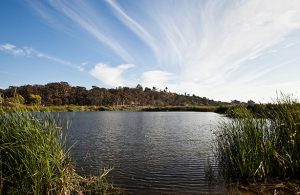The new grant gives the agency about half the money it needs to finish the engineering and design work that must be completed before the project can be offered for construction bids.
“We still need a little over $4 million to get the project shovel ready,” said Kim Smith, a senior environmental planner for SANDAG, at a recent meeting of the Buena Vista Lagoon Joint Powers Committee.
The North County lagoon was one of 23 ecosystem restoration and protection projects selected statewide to receive a total of $26 million recently from the Fish and Wildlife Department through its Proposition 1 Watershed Restoration Grant and Delta Water Quality and Ecosystem Restoration Grant Program.
The agency has applied for more grants to complete the work, she said.
No funding has been allocated so far for construction, which is expected to cost between $80 million and $90 million. The restoration should be finished in three to four years after the construction contract is signed.
SANDAG’s board of directors approved the lagoon restoration plan in 2020 after decades of negotiations between residents and the government agencies involved. A weir or low dam at the outlet will be removed to allow ocean water to flow in and out, changing what has become a freshwater marsh back to a saltwater wetland.
Much of the lagoon will be excavated to remove the silt and cattails that have been slowly filling the basin for decades and to open a new channel to the ocean.
A wildfire last month may have brought new attention to the need for restoration.
About 10 acres of the cattails burned in a fast-moving blaze June 25 that threatened nearby homes, the Buena Vista Audubon Society Nature Center and other structures. Afterward, a man was arrested on suspicion of arson.
Besides the potential fire danger, the lagoon provides a home for mosquitoes that plague nearby residential neighborhoods. During the annual rainy season, the clogged lagoon is also a flood hazard.
State Fish and Wildlife Manager Ed Pert said at the meeting that he’s working with the U.S. Army Corps of Engineers to get more of the cattails removed as soon as possible. Because of the mosquito and fire hazards, residents around the lagoon would like it cleared before the restoration that is still years from completion.
“One of the problems we have as a state agency maintaining part of the lagoon is we can’t remove vegetation because of the Ridgway rail,” Pert said.
The endangered species of native bird nests in the lagoon, and state law prohibits removing the cattails during its breeding season.
Also, the cattails tend to grow back quickly, he said. They can be sprayed with an herbicide, but a more long-lasting solution is to pull the plants up by the roots.
“If we pull a lot of those up, it turns into what’s called a dredging project, basically,” Pert said. “That would require a permit from the Army Corps of Engineers … and it can be difficult to get.”
Homeowners along the lagoon have asked for at least the cattails nearest their property to be removed to create a fire barrier, he said.

 The $1 million announced last month comes on top of $3 million the state Wildlife Conservation Board awarded in December to SANDAG, which oversees planning and contracting for the proposed cleanup of the stagnant 220-acre lagoon.
The $1 million announced last month comes on top of $3 million the state Wildlife Conservation Board awarded in December to SANDAG, which oversees planning and contracting for the proposed cleanup of the stagnant 220-acre lagoon.